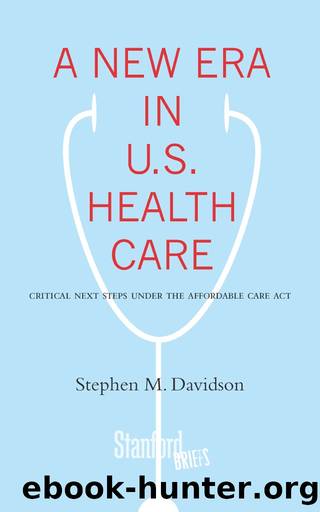A New Era in U.S. Health Care: Critical Next Steps Under the Affordable Care Act by Stephen Davidson

Author:Stephen Davidson [Davidson, Stephen]
Language: eng
Format: epub
Tags: Social Policy, Public Policy, Political Science
ISBN: 9780804787239
Google: CMY5-BAjCPgC
Goodreads: 18924856
Publisher: Stanford University Press
Published: 2013-04-24T00:00:00+00:00
4
MAKING CHANGE
The most useful way to see the Affordable Care Act is as a law that provides a variety of tools, incentives, and grants that create opportunities for public officials and others to accomplish many good things both for the health system as a whole and for individual Americans who depend on and use that system. The corollary is that what is actually accomplished under the law depends on how well those opportunities are used.
The people who will have the largest roles in determining the actual accomplishments include the following:
⢠Federal civil servants and others in the executive branch who will create and then enforce the regulations required to implement the law.
⢠The Congress, which, through its power over the purse, can fund the new law adequately or starve it so that its promise cannot be realized.
⢠State officials who will create the health insurance exchanges (or not), regulate insurance plans, and operate the Medicaid program, among other things.
⢠Clinicians and other leaders of health care delivery organizations. For the law to lead to more reliable quality and to contain expenditures will require above all that doctors and other clinical professionals make differentâthat is, betterâclinical decisions that produce more salutary patient utilization patterns. In other words, it is up to them to create improved care-giving processes that produce more reliable quality of care, fewer medical errors, fewer unnecessary and duplicate services, and reduced costs. To generate those results will require the leaders of health care delivery organizationsâfrom one- or two-person medical offices to multispecialty group practices, hospitals, and other large organizationsâto develop and implement new policies and practices that accomplish those goals.
⢠Individuals who (1) obtain comprehensive health insurance (many will simply retain the policies they already have) and (2) use health care services differently than they do at present to produce new and more effective aggregate utilization patterns.
Getting Congress to pass the ACA was a monumental legislative accomplishment. Making sure that the new law lives up to its promise shifts the focus to implementation. In part, that means detailed work by career officials in federal and state governments over a period of several years. As Rogan Kersh put it, âImplementing the Affordable Care Act will take years . . . and involves a mountain of intricately specified new regulations. Even apparently simple sections require extensive elaboration.â1 The paragraph in the law providing that children could remain on their parentsâ health insurance until age twenty-six generated âmore than two dozen pages of regulatory details in the Federal Register.â2
But implementation is more than technical work by anonymous bureaucrats. âVirtually every provision in the ACA provides a fresh political battlefield, training a spotlight on regulators accustomed to laboring in relative privacy.â3 And that means more politics, because the fact is that parties with many different interests have important roles to play under the new law or will be affected by it. And it is only natural to expect that they will act to protect their interests.
Although the process contains many opportunities for
Download
This site does not store any files on its server. We only index and link to content provided by other sites. Please contact the content providers to delete copyright contents if any and email us, we'll remove relevant links or contents immediately.
| Administration & Medicine Economics | Allied Health Professions |
| Basic Sciences | Dentistry |
| History | Medical Informatics |
| Medicine | Nursing |
| Pharmacology | Psychology |
| Research | Veterinary Medicine |
Machine Learning at Scale with H2O by Gregory Keys | David Whiting(3659)
Fairy Tale by Stephen King(2967)
Will by Will Smith(2593)
Hooked: A Dark, Contemporary Romance (Never After Series) by Emily McIntire(2428)
Rationality by Steven Pinker(2159)
Friends, Lovers, and the Big Terrible Thing by Matthew Perry(2018)
The Becoming by Nora Roberts(1932)
Love on the Brain by Ali Hazelwood(1828)
HBR's 10 Must Reads 2022 by Harvard Business Review(1703)
The Strength In Our Scars by Bianca Sparacino(1702)
A Short History of War by Jeremy Black(1679)
Leviathan Falls (The Expanse Book 9) by James S. A. Corey(1530)
515945210 by Unknown(1525)
Bewilderment by Richard Powers(1454)
443319537 by Unknown(1400)
A Game of Thrones (The Illustrated Edition) by George R. R. Martin(1377)
The Real Anthony Fauci: Bill Gates, Big Pharma, and the Global War on Democracy and Public Health (Childrenâs Health Defense) by Robert F. Kennedy(1337)
The 1619 Project by Unknown(1322)
Fear No Evil by James Patterson(1252)
